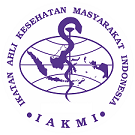Correlation between Nutritional Status and Diarrhea in Toddlers at Slawi Health Center, Tegal, Central Java, Indonesia
DOI:
https://doi.org/10.26911/thejmch.2024.09.06.04Abstract
Background: Diarrhea is a symptom of infection caused by bacteria, viruses, or parasites. It remains a significant public health issue in Indonesia that requires continued research and effective solutions. This study aimed to determine the relationship between nutritional status and the incidence of diarrhea among toddlers at the Slawi Public Health Center, Tegal Regency.
Subjects and Method: A cross-sectional study was conducted in the working area of the Slawi Public Health Center from June to July 2023. A total of 190 subjects were selected for the study. The dependent variable was the incidence of diarrhea, while the independent variable was nutritional status. Nutritional status data were collected using height-for-weight measurements. Data were analyzed using the chi-square test.
Results: Nutritional status was found to be associated with the incidence of diarrhea among toddlers. Toddlers with abnormal nutritional status had a 1.73 times higher risk of experiencing diarrhea compared to those with normal nutritional status, and this result was statistically significant (OR = 1.73; 95% CI = 1.13–2.66; p = 0.005).
Conclusion: Abnormal nutritional status is associated with a higher incidence of diarrhea among toddlers.
Keywords:
diarrhea, nutritional status, toddlersHow to Cite
References
Aiman U, Agustiani W, Indriani NCL, Hijratulmarah H, Fuadi N (2024). The relationship between food availability, household food security, and the history of infectious diseases with the incidence of malnutrition in toddlers. J World Sci, 03(02): 155-165. https://doi.org/10.58344/jws.v3i2.540
Alim M, Hasan M, Masrika N (2021). The relationship between diarrhea and nutritional status in toddlers at Dr. H. Chasan Boesoirie Regional General Hospital. Kieraha Med J, 3(1): 1–6. https://doi.org/10.33387/kmj.v3i1.3262
Amin L (2015). Management of acute diarrhea. Cont Med Educ, 42(7): 504–508. https://doi.org/10.55175/cdk.v42i7.986
Ansuya, Nayak BS, Unnikrishnan B, George A, Shashidhara YN, Mundkur S, Guddattu V (2018). Risk factors for malnutrition among preschool children in rural Karnataka: a case-control study. BMC Public Health, 18(1): 283. https://doi.org/10.1186/s1288901851243
Astiti F, Zuraida R, Bakri S, Berawi K (2022). Analysis of the influence of nutritional status variables and environmental sanitation on the event of diarrhous to children. J World Sci, 1(11): 998–1017. https://doi.org/10.58344/jws.v1i11.112
Bangura JB, Xiao S, Qiu D, Ouyang F, Chen L (2020). Barriers to childhood immunization in sub-Saharan Africa: a systematic review. BMC Public Health, 20(1): 1108. https://doi.org/10.1186/s12889020091694
Junita J, Rusmimpong R, Triana W (2023). Simpatik education model for knowledge and diversity of food intake for stunting toddlers in Kerinci Regency. Int Conf Publ Health J, 2. https://doi.org/10.35910/icohpj.v2i0.694
Karina SM (2023). Relationship between early initiation breastfeeding, exclusive breastfeeding, complementary feeding, and nutritional education with nutritional status of children under three years. Gac Med Caracas, 131(4S): S524-S530. https://doi.org/10.47307/gmc.2023.131.s4.5
Kii YI, Nur ML, Sahdan M (2024). The relationship of mother’s education level, mother’s knowledge, family income and nutritional status of toddler in the working area of the Weekombak Puskesmas, West Sumba District. J Ageing Fam, 2(2): 107-111. https://doi.org/10.52643/joaf.v2i2.4141
Lestari S, Yusita I, Mulyati I, Oktafiani H, Sugiharti I, Hayati N, Sarbini A (2023). The utilization of MCH books by families in monitoring the nutritional status of toddlers. Oper Res Int Conf Ser, 4(1): 17-22. https://doi.org/10.47194/orics.v4i1.212
Li Y, Xia S, Jiang X, Feng C, Gong S, Ma J, Fang Z, Yin J, Yin Y (2021). Gut microbiota and diarrhea: an updated review. Front Cell Infect Microbiol, 11: 625210. https://doi.org/10.3389/fcimb.2021.625210
Linda IN, Daryanti MS (2022). Relationship of nutritional status with diarrhea among children in Sumenep Regency. Int J Health Sci Technol, 3(3): 100-108. https://doi.org/10.31101/ijhst.v3i3.1987
Linsalata M, Riezzo G, Orlando A, D’Attoma B, Prospero L, Ignazzi A, Losurdo G, et al (2023). The role of intestinal barrier function in overweight patients with IBS with diarrhea undergoing a long-term low FODMAP diet. Nutrients, 15(21): 4683. https://doi.org/10.3390/nu15214683
Ma'arif M, Nafies D, Suparmi (2021). The relationship between diarrhea incidence and nutritional status of toddlers in Sidorejo Village, Tuban Regency. J Gizi Aisyah, 4(2): 35–41. https://journal.aisyahuniversity.ac.id/index.php/JGA/article/view/kejadiandiaredian/kejadiandiaredian
Mardalena I, Suryani E (2016). Nutrition science. Jakarta: Ministry of Health, Republic of Indonesia.
Nur ZT, Suryana S (2021). Risk of factor on history disease with nutritional status on toddlers aged 24–59 months in Pidie Jaya District. J Nutr Sci, 2(1): 7-12. https://doi.org/10.35308/jns.v2i2.3347
Nurprastiwi AG, Sasongko NA, Kurniyawan EH, Nur KRM, Afandi AT, Kurniawan DE (2024). The impact of farmer families’ communication in compliance nutritional needs among toddlers. Health Technol J, 2(5): 543-554. https://doi.org/10.53713/htechj.v2i5.217
Putri ND, Novelia S, Ariesta EM (2024). Factors associated with the incident of diarrhea among children. Nurs Health Sci J, 4(1): 110-118. https://doi.org/10.53713/nhsj.v4i1.349
Rahmawati A (2019). Exclusive breastfeeding and nutritional status and their relationship to diarrhea incidence in toddlers in the Juntinyuat Community Health Center area. Gema Wiralodra. 10(1): 105–114. https://doi.org/10.31943/gemawiralodra.v10i1.14
Rasyid N, Yunola S, Chairunna C (2021). The relationship between education, exclusive breastfeeding, and toddler nutritional status with diarrhea incidence in toddlers in the working area of UPTD Tanjung Baru Baturaja Health Center in 2021. J Doppler. 5(2): 78-84. https://journal.universitaspahlawan.ac.id/index.php/doppler/article/view/2536
Riskesdas (2019). Central Java Province Report of the 2018 Basic Health Research. Jakarta: Lembaga Penerbit Balitbangkes.
Saputro H, Tnomel K, Wahyuningsih AS, Acob JRU (2023). Children growth analysis reviewed from nutrition status of children age 0–5 years. Open Access Health Sci J, 4(1): 19–24. https://doi.org/10.55700/oahsj.v4i1.35
Sasmito P, Setyosunu D, Sadullah I, Natsir RM, Sutriyawan A (2023). History of nutritional status, exclusive breastfeeding and diarrhea incidence among toddlers. Holist J Kesehatan, 17(5): 431-438. https://doi.org/10.33024/hjk.v17i5.12409
Soboksa NE, Gari SR, Hailu AB, Alemu BM (2020). The association of water supply, sanitation and hygiene interventions and childhood malnutrition in Kersa and Omo Nada Districts of Jimma Zone, Ethiopia: a case-control study. Res Sq. https://doi.org/10.21203/rs.2.24114/v1
Supriadi D, Nurhayati LS, Khaerunnisa RN, Suhanda (2020). Correlation of nutritional status with diarrhea incidence. Genius J, 1(1): 1–4. https://doi.org/10.56359/gj.v1i1.3
WHO (2017). Diarrhoeal disease. World Health Organization. https://www.who.int/news-room/fact-sheets/detail/diarrhoeal-disease
Yulvia NT, Selfianita D, Panjaitan TG, Novanty R, Liawati L (2024). Education on monitoring nutritional status of toddlers in Kedungsoka Village, Puloampel Subdistrict, Serang Regency, Banten Province. J Inov Gizi, 2(4): 101–108. https://doi.org/10.55606/jig.v2i4.3203.










